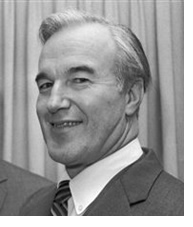About
In Memoriam: Britton Chance,
Nov 16, 2010
In memoriam: Britton Chance, 1913-2010
 Britton Chance, an OSA Fellow Emeritus whose work in biomedical optics helped develop spectroscopy as a noninvasive way to diagnose medical problems, died on 16 November 2010 in Philadelphia, PA. He was 97.
Britton Chance, an OSA Fellow Emeritus whose work in biomedical optics helped develop spectroscopy as a noninvasive way to diagnose medical problems, died on 16 November 2010 in Philadelphia, PA. He was 97.
Chance was the Eldridge Reeves Johnson Emeritus Professor of Biophysics, Physical Chemistry and Radiologic Physics at the University of Pennsylvania. He was also an Olympic Gold Medalist (1952, Sailing, Men’s 5.5 Meter Class), a recipient of the US National Medal of Science (1974), and a holder of a President’s Certificate of Merit for his sensitive work during World War II in the development and enhancement of radar. His work was continuously funded for a remarkable 70 years, and over the course of his extraordinary career he had six papers that reached more than 1,000 citations.
From an early age, Chance displayed a passion for sailing and a knack for invention. These interests came together early, when as a teenager he invented and patented an automatic ship steering device to prevent vessels from sailing off-course. He was later contracted by the British General Electric Company to test the device in a 20,000 ton freighter between England and Australia.
In 1935, Chance earned his bachelor’s degree in chemistry from the University of Pennsylvania. He went on to earn two doctoral degrees, one in physical chemistry from the University of Pennsylvania in 1940 and another in biology and physiology from Cambridge University in 1942. When the United States entered World War II, Chance was recruited to M.I.T. to work in its Radiation Laboratory as part of a secret team. He helped develop a radar system that allowed blimps to spot German submarines off the Eastern Seaboard, and he also invented a ground position indicator to enable more accurate bombing. Chance left in 1945 to work with Hugo Theorell at the Karolinska Institute. Their work on the role of NAD as a coenzyme in the oxidation of alcohol in cellular respiration was later named the Theorell-Chance mechanism.
Chance returned to Philadelphia in 1947. From 1949 to 1983, he was an enzyme researcher, professor of biophysics and physical chemistry, and director of the Eldridge Reeves Johnson Foundation for Medical Physics at the University of Pennsylvania, where the Stellar-Chance Laboratories are named for him. He became an active emeritus professor in 1983. In the 1990s, Chance was director of the Institute for Biophysical and Biomedical Research, part of the University City Science Center, and in 1995 he was appointed president of the Medical Diagnostic Research Foundation (MDRF) in Philadelphia. He continued working until the end of his life, publishing several papers in 2010.
The major focus of Chance's research was the elucidation of enzyme kinetics. Early in his career he invented a tool, known as a stopped-flow apparatus, for measuring chemical reactions involving enzymes; it let to the establishment of a fundamental principle of enzyme kinetics known as the enzyme-substrate complex. As a result of his invention of the dual-wavelength spectrophotometer (built and sold by Aminco), he revealed the role of coenzymes in oxidative phosphorylation in mitochondria. Other discoveries formed the basis for the glucosometers in use today. His later work in magnetic resonance spectroscopy and near-infrared optics aided in the development of techniques for the analysis of muscle dynamics and tools to detect cancer tumors in muscles and breasts and to assess cognitive brain function.
An OSA member since 1964, Chance was elected as an OSA Fellow in 1975. He was also a Fellow of APS and SPIE, and a Foreign Member of the Royal Swedish Academy of Sciences, Medical Sciences (1968) and the Royal Society (London) (1981). He was elected to the US National Academy of Sciences in 1952 and was the recipient of numerous other awards and prizes, including the Franklin Medal from Philadelphia’s Franklin Institute; the Heineken Prize for Biochemistry and Biophysics from the Netherlands Academy of Science and Letters; the Benjamin Franklin Medal for Distinguished Achievement in the Sciences, given by the American Philosophical Society (for which he served as vice president); and the Christopher Columbus Discovery Award in Biomedical Research from the National Institutes of Health.
Chance is survived by his third wife, Shoko Nioka, a Japanese biochemist whom he married in February 2010 in a traditional Chinese ceremony held Tainan, China; 11 children; five stepchildren; 20 grandchildren; and eight step-grandchildren.
If you would like to make a memorial donation to the OSA Foundation in honor of Britton Chance, please visit www.osa-foundation.org/give . Gifts in Dr. Chance’s memory can also be made to the Johnson Research Foundation, payable to the Trustees of the University of Pennsylvania, Penn Medicine Development, Suite 750, 3535 Market Street, Philadelphia, PA 19104-3309.
